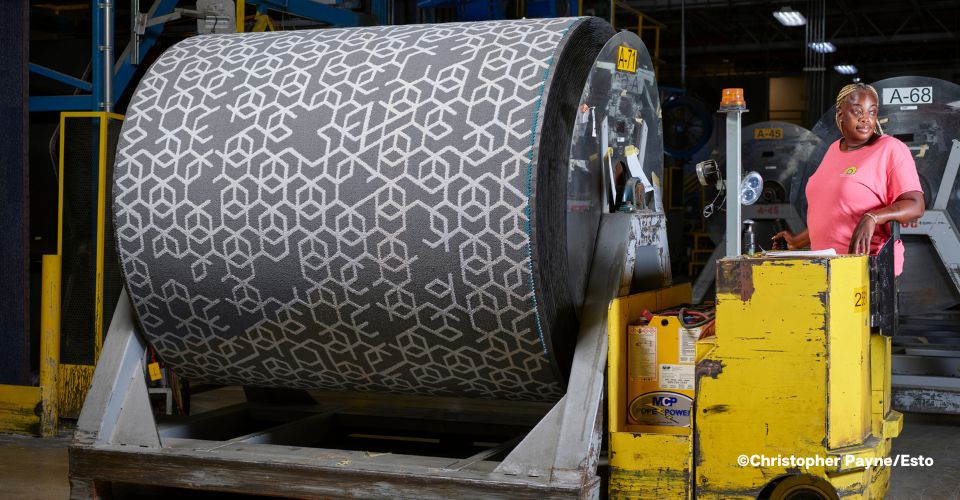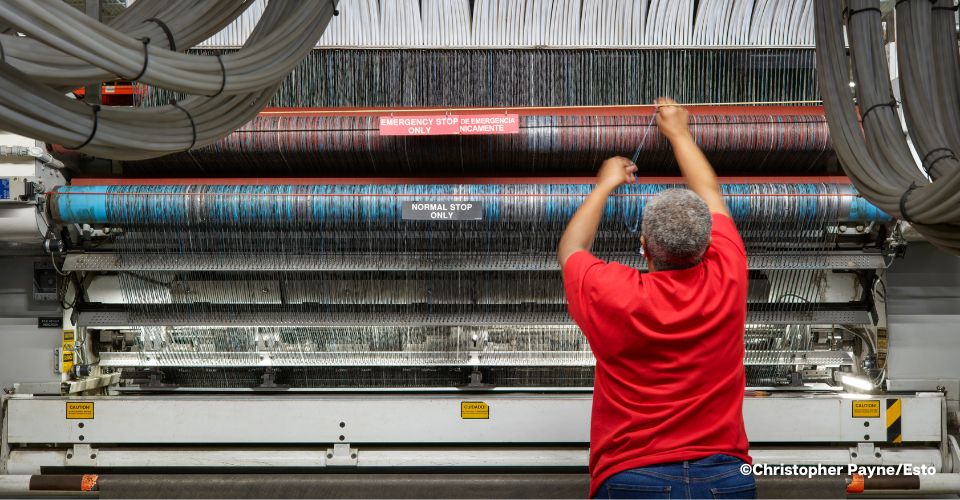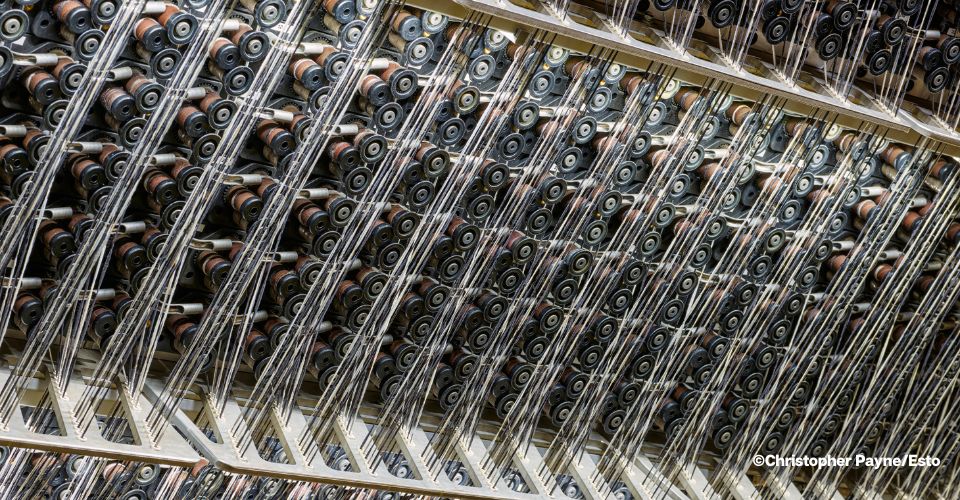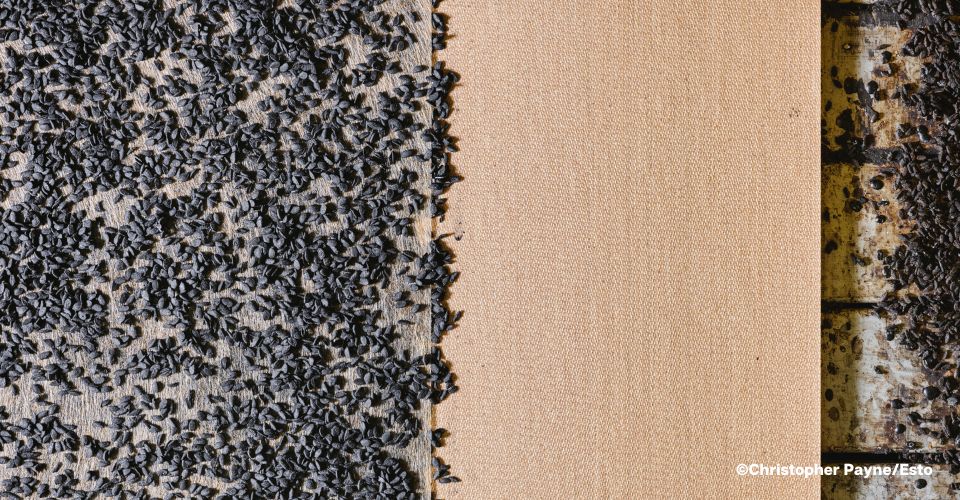Last year, The New York Times Magazine included our carbon negative innovation in its Climate Issue, highlighting our journey to develop the world’s first cradle-to-gate carbon negative carpet tile. The NYT Magazine hired industrial photographer Chris Payne to photograph our factories in Troup County, Georgia, for the piece. In addition to capturing the people and processes behind our products and creating art, he was kind enough to share his experience shooting the space.
Interface: How did you go from being an architect to a professional photographer?
Chris Payne: About 20 years ago, I was working on a book about these old power stations in New York that were used to power the subway. I’d make these really intricate drawings of the machinery while on-site, but I couldn’t finish them on time. So, I started to take photos to use for reference at home. Over time I started to enjoy taking photos of the machines as much as I did drawing them. Then, when my friend who was originally supposed to do the book photography backed out, I just thought to myself, “Well, why don’t I just do it?”
I: How did you get interested in industrial design to begin with? What about it draws you in?
CP: I’ve always been interested in infrastructure and how things work. As a kid, I liked to explore the underbelly of Boston, where I grew up. And these are places that most people can’t get into. So, by gaining access to your factory or a similar kind of factory, I can kind of turn that into a personal project and take pictures that no one else has ever seen.
I find it challenging to extract beauty out of something that most people would dismiss as being uninteresting or just kind of ugly. I find it very gratifying when I can make a factory like yours, which is pretty good looking to begin with, look beautiful and have people say, “Wow, I never thought this could look like that!”
I: Tell us about your work in your own words.
CP: I’m always trying to separate the clutter from the beauty and find clarity in the chaos. I think of my photographs as these beautiful drawings that are kind of thought out and organized, and they can stand alone as eye candy, but they also contain something interesting about the process. They help explain something in the way that an architectural drawing would.
I: What is your process like?
CP: Well, with your plant, it was homing in on particular machines that I thought were beautiful. Like the backs of those tufting machines – I still can’t figure out how that all works. I love learning about these places, but I also like being confounded no matter how many times I look at them. And so, it’s finding those moments, those machines, those details, where you don’t have to understand the process to appreciate its complexity and its inherent beauty and the kind of ingenuity that was required to invent something like that.
There’s also looking at the employees and watching what they do. There are many of these repetitive moments where what they’re doing is beautiful, and they’re doing it in a very graceful way.
If I can watch them long enough, I can pinpoint when that moment is. Then it’s the balance of machinery and adding lighting to really make the scene look dramatic and drown out the background so that your eye is focused only on what’s important.
I: Factories can be very cramped, but your photos have this sense of openness to them. How do you manage to capture that perspective?
CP: It depends on the lens I use. The important thing is picking the right viewpoints. The challenge with a factory like yours is that you walk in, and it’s amazing. Everywhere you look, it’s like, “Oh, this is cool! That’s cool!” But just because it’s interesting to look at within the space doesn’t mean it’s going to translate into a beautiful two-dimensional picture. As a photographer, the challenge is separating the experience from the art.
I: When you were at Interface, were there any particular things you looked for?
CP: The tufting machine. I’d never seen the back of that before, with all the little circles. Honestly, as soon as I saw that I knew we were going to be okay. I knew that I would be able to give the magazine at least one truly beautiful image where you have no idea what you’re looking at, but you know it’s awesome.
I will say that probably my favorite picture from the whole shoot was a man who worked there, and he set was setting up small batch tufting or prototypes, but he’s kind of underneath the machine. As soon as I saw that, I said, “That’s gonna be the shot.” Then when we set it up the next day, I knew what I wanted. And the guy in there, he was great; he’d been there forever. And he just has that look – it was perfect. I knew that I wouldn’t get that again because the way you manufacture is kind of unique.
I: What stood out about the Interface process?
CP: So, there were pictures that I couldn’t really show the scale of. And there was one picture I did take, which turned out better than I thought, looking down on that conveyor where you see all the little pieces of backing material. Oh, I would’ve liked to spend more time in the factory where they put the layers of the backing together. I was able to get one picture there, but I would have liked to have seen more. I haven’t seen that really anywhere else.
I wish more places were like Interface. We’ve lost that ability to kind of understand how we make things. These days, factories are not as proud to show off what they do the way they used to be.
Check out the full article, “Has the Carbontech Revolution Begun?”, to view more of Chris’s photography captured at our factory. To see additional work from Chris, visit his portfolio and be on the lookout for future exhibits to view his work in person.



